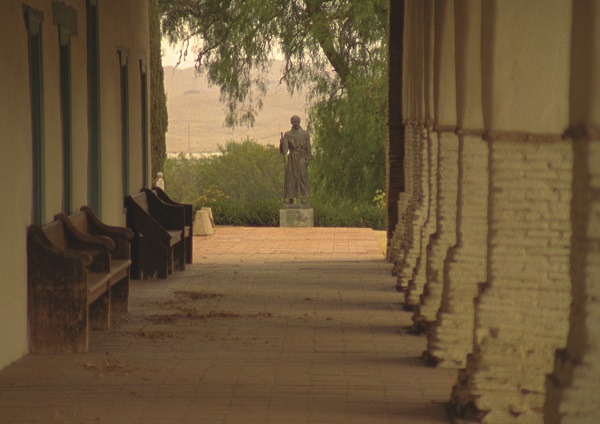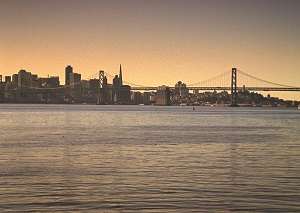On ‘The Royal Road’ to Sundance with Filmmaker Jenni Olson

A still from the film “The Royal Road.” Photo courtesy of Jenni Olson Productions.
Travel the road with experimental lesbian filmmaker Jenni Olson and you’re in for quite a ride — Don Juan, Alfred Hitchcock, Kim Novak, even Father Junípero Serra are all part of her rambling, confessional narrative. If this doesn’t sound exactly regal, you’re right. Through Olson’s lens, The Royal Road of her film title that is headed for this year’s Sundance Film Festival is not really a road at all but a series of images — palm trees, bungalows, deserted alleyways, freeway ramps, Spanish missions, container ships and more — that roll lazily by, all the while accompanied by Olson’s nostalgic-yearning voice that identifies itself as a butch Casanova. “The only difference is,” she tells us, “Casanova got the girl.”
I mentioned references to the likes of movie directors and film stars, but it’s important to note in this documentary that there are no living, breathing human beings to be found. Obviously, there are drivers behind the wheel in those long takes of bumper to bumper traffic, but no close-ups that would actually reveal the back of a head or an outstretched arm. Granted, Father Junípero Serra, the founder of California’s series of missions that stretch along the part mythical, part real trail from Los Angeles to San Francisco, puts in several appearances. But he’s as you might expect a bronze cast version of saintly beneficence to be. A flock of birds are seen at one point along with an iconic view of the Golden Gate Bridge, but they would hardly be classified as featured players.
So what gives? We are simply in a universe of Olson’s making, who advises us early on that hers is “a story about how nothing happens.” Olson is in the true sense of the word, an experimental artist. The absence of actors or real life personages, as well as the decision to tell us her tale of unrequited love — the camera lingering in front of shut up houses as she confesses in a pining, somnambulistic monotone of her desires — is a deliberate one. This is one filmmaker who is nothing if not honest about her intentions.
Often self-deprecating in her narration, she is sentimentally attached to the movies that have captured her own sense of loneliness. There are many film addicts among us but for Olson her search goes further. She tells us: “I am experiencing myself as a fictional character as a mode of survival.” Ironically, her first allusion is to William Holden in Sunset Boulevard (1950), who for anyone who has seen the film will tell you, ends up face down in aging film star Norma Desmond’s swimming pool. Hardly a paragon of survival. Olson’s journey to LA centers on her search for a certain Juliet, who exemplifies everything beautiful and sexy in a partner. Even if the girl were available, we get the sense the illusion is more desirable.
Olson’s greatest fictional film obsession is on Alfred Hitchcock’s Vertigo (1958). Jimmy Stewart’s fixation as Scottie on Kim Novak’s Madeleine hits the perfect note for her fascination with nostalgia. “Nostalgia could be the thing that saves us,” she tells us in her voiceover. We get extended glimpses of the cemetery and Mission Dolores that figure in the story. The character of Madeleine herself is fixated on one Carlotta Valdes, a figure from San Francisco’s past. For Olson, the film becomes a symbol of longing for a California that no longer exists — the pure ecology and beauty of the land is one aspect, perhaps even its Mexican heritage before human greed and the natural unstoppable flow of progress took its toll.

A film still courtesy of Jenni Olson Productions.
How does Olson defend the absence of characters in her own film when she is so struck by the magic of characters in other directors’ works? By expounding her deep spiritual belief that unlike people, the land itself endures for many generations, she manages to convince us of the sincerity of her approach. She sees the state as a once upon a time “genus of greenery” now marred by exhaust. She tells us how Highway 280 South used to advertise itself as “the world’s most beautiful freeway” but the sign was removed when it proved otherwise.
Carefully orchestrated shots hold for almost interminable moments on the landscape. A slant of light, an abandoned street can convey great beauty. Such long takes force us to look in a new way, to accept or not accept a rhythm of focusing that we are largely unused to seeing. There are exceptions, of course — the early films of Michelangelo Antonioni and Terrence Malick immerse us in the act of suspended looking, yet rely on story as background. With Olson, there are two principle realities in The Royal Road — the image at hand and the disembodied voice. At times, however, her stream of consciousness narrative has little in common with the camera’s subject. But that is not her point. This is, above all, a subjective enterprise. We can only trust that she will lull us over like a lazy repetitive mantra, becoming her willing observers.
Briefly interspersed are a series of maps of the country at large. These detail such events as the Louisiana Purchase and the California Gold Rush of 1849, but she is quick to advise that the Mexican Wars concluded in 1848, with Mexico ceding over 50 percent of their land to the U.S. From coast to coast, Manifest Destiny had its way. Whether her history lesson will inspire us to look for deeper resonances along the Camino Real is anybody’s guess.
It’s a brave approach that Olson has given us. Does she succeed? In her words: “I wanted to tell you a story, love…loss…that reveals more about me than I ever expected to say.” Such honesty is rare and for those willing to go along with such a steady, unwavering heartbeat of a film, there are rich rewards to be had.
***
On January 12, I had a phone interview with Jenni Olson, who has been a resident of San Francisco for some time and active in the film and LGBT community there. Though carefully pacing her more challenging responses, she seemed warm and willing to share her opinions with me. We began our conversation by briefly talking about our shared love of movies and the mystique of California, myself as a native who moved East and Olson as a recent convert from her home state.
GALO: You wrote this love poem about the state of California. How did you end up there?
Jenni Olson: I came from Saint Paul, Minnesota. I had started the first gay film festival in Minnesota back in the mid ’80s and the folks here streamlining The San Francisco International Film Festival invited me to be the co-director of the festival in 1992, and since it was the best job in the world in my tiny profession, I said yes. I applied for the job and they hired me.
GALO: That’s wonderful. You were actually invited.
JO: Yes. I wasn’t a big San Francisco fan, it was a job. As I say in the film, I came and fell in love with the city.
GALO: As many people do with San Francisco. You’ve said that you crave the “catharsis of narratives.” You are a lover of movies and novels. And yet your deliberate choice to focus on landscape and employ an almost disembodied voice over narrative seems to be the antithesis of developing characters to people your imagery. Are you content with putting yourself alone into the monologue you’ve created?
JO: I love that observation. It’s an interesting thing to be talking about. I never wanted to make conventional films, or conventional documentaries or even conventional experimental films. So there’s meant to be something very kind of meta about the whole thing, in the same way Sunset Boulevard is a Hollywood movie about Hollywood movies, The Royal Road is a film about films. And so there is a way of using this very nontraditional style of storytelling that I’ve been able to do that; I think of it as an essay film, that I’m really reflecting on a lot of various thing… I could just write it as an essay, but I really like the approach of combining what would be a written thing with the imagery and the magic that happens in that combination.
GALO: It is a very interesting and unique combo, I must say.
JO: I think…to say the other thing about the writing and the inspiration and my interest in that, I think the writing is kind of poetic in its density and structure. And I’m very inspired by poets and poetry. I like what you said that it’s like a love poem to California and to the movies and in the visuals — the seeing.
GALO: You obviously possess a talent in your narratives for the written word. Some of your stream of consciousness brings to mind the romantic searching of a Jack Kerouac novel or a Lawrence Ferlinghetti poem, two writers obviously entranced by San Francisco as well as the open road. Could you see yourself developing your interior voice on the page?
JO: Yeah… [Pause] I do a lot of writing, but I haven’t done a lot of publishing, creative writing. I’m also a film historian, so I do a lot more non-fiction writing about film, and it’s a lot more vulnerable to do creative. I haven’t got around to that — a couple of short stories here and there. But it’s interesting. Kerouac, in some ways, has been an inspiration. I mostly am not the hugest fan of Ferlinghetti, but I have a really great poem of his in my previous film, Joy of Life. I got him to let me use an archival audio of him reading his poem, The Changing Light, the changing light of San Francisco.
GALO: I thought I knew most of his work but I don’t think I know that one.
JO: It’s very different from most of his work — so I like it. [Laughing] I don’t know why, but I’ve never been a fan of his work. But in terms of a personal voice…
